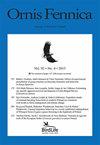在挪威北部的一个岛上,鹰鸮(Bubo Bubo)的活动范围和电线杆的使用
IF 1.2
4区 生物学
Q2 ORNITHOLOGY
引用次数: 0
摘要
几十年来,靠近北极圈的密集岛屿上的鹰鸮(Bubo Bubo)由于电力线(触电和碰撞)而遭受了相当大的死亡率。2009年至2014年期间进行了一项使用GPS发射机技术的研究。我们研究了栖息地大小、扩散距离、死亡率,并提出了预防事故的缓解技术。我们发现,正如预期的那样,幼鹰鸮的活动范围比成年鹰鸮大,活动范围也比成年鹰鸮远,但这两个年龄组的活动范围都比欧洲其他地区小得多。可能的原因被认为是这个种群被周围的海洋隔离了,这可能是一个屏障。GPS数据表明,栅格的极点被用作栖息柱的情况超出了随机分布的预期。这可以解释为这些低岛上缺乏高大的树木和其他高架景观特征。为了减轻猫头鹰的伤害,我们设计了一个安装在杆子上的栖息装置,以防止猫头鹰被电死。目前,在触电风险高的沿海地区,几家电网所有者都在使用这种方法,挪威的Eagle-Owl国家行动计划也在跟进。本文章由计算机程序翻译,如有差异,请以英文原文为准。
Home-range, movements and use of powerline poles of Eagle-Owls (Bubo bubo) at an island population in northern Norway
A dense island population of Eagle-Owls (Bubo bubo) close to the Arctic circle had suffered considerable mortality due to powerlines (electrocution and collision) throughout many decades. A study using GPS transmitter technology was carried out between 2009 and 2014. We studied home-range sizes, dispersal distances, mortality, and proposed mitigation techniques to prevent accidents. We found as expected that juvenile Eagle-Owls had larger home-ranges and moved farther than adults, but both age-groups moved much less than shown elsewhere in Europe. The probable reason for this was thought to be that this population was isolated by the surrounding sea, which might act as a barrier. The GPS data indicated that the poles of the grid were used as perching posts more than expected from a random distribution. This was explained by the lack of high trees and other elevated landscape features on these low islands. As a mitigation effort, we contributed to designing a perching-device for fitting on the poles that would prevent electrocution of the owls. This is now used by several grid-owners in coastal areas with high electrocution risk and is followed up by the National action plan for Eagle-Owl in Norway.
求助全文
通过发布文献求助,成功后即可免费获取论文全文。
去求助
来源期刊

Ornis Fennica
生物-鸟类学
CiteScore
2.00
自引率
0.00%
发文量
14
审稿时长
>12 weeks
期刊介绍:
Ornis Fennica is a peer-reviewed international ornithological journal published by BirdLife Finland. Ornis Fennica publishes analytical and experimental papers on the ecology, behaviour and biogeography of birds. Ornis Fennica prefers studies concerning Fennoscandian species, but other novel contributions of general interest are most welcome as well.
Ornis Fennica is an open-access journal without page charges for publication. All published articles (from 1924 onwards) are freely available from the journal website. First decisions are usually made within three months of submission.
 求助内容:
求助内容: 应助结果提醒方式:
应助结果提醒方式:


